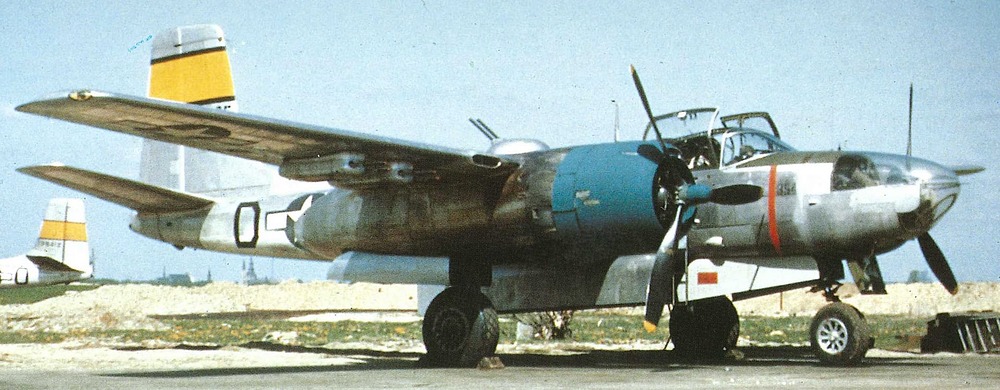Description and History
The Douglas A-26 Invader was a twin-engined American light bomber and ground attack aircraft designed to replace the aging Douglas A-20 Havoc. In that sense, the A-26 was essentially a successor to the Havoc. The prototype XA-26 made its first flight on July 10, 1942. Initial design issues, such as engine cooling problems, were resolved during later development.
The first production version was the A-26B, a dedicated ground-attack aircraft equipped with a solid gun nose. It first saw combat in the Pacific Theater in June 1944, although with negative feedback from the Army Air Corps stationed there, and later in Europe by November of the same year.
In parallel development with the A-26B, the A-26C was developed as a bomber version with a glass nose. Crewed by three, the bombardier, who also served as navigator, was stationed in the nose section and operated the Norden bombsight for high-altitude bombing. The A-26C often acted as a lead-ship in bombing formations, guiding accompanying A-26Bs. Once the A-26C dropped its payload over the target, the following aircraft would release their bombs in unison.
Armament on the A-26C was similar to the A-26B. However, instead of six to eight forward-firing machine guns in the nose, the A-26C had two fixed 0.50 caliber machine guns mounted on the lower starboard side of the nose. Like the B model, it retained two remote-controlled turrets for defense.
Douglas produced 1,091 A-26Cs in total: 1,086 at the Tulsa facility, in Oklahoma, and five at Long Beach, California. Production blocks ranged from A-26C-1-DL to A-26C-55-DT.
From the A-26C-30-DT block onward, Invaders on the production line were fitted with a clamshell-style canopy to improve visibility and bailout safety. Beginning with the A-26C-45-DT, production aircraft were equipped with water-injected R-2800-79 engines and underwing rocket provisions. Later blocks (A-26C-55-DT and beyond) integrated six internal wing-mounted machine guns, replacing earlier models’ externally mounted package guns.
The A-26C-25-DT variant, proposed here for inclusion, was powered by the earlier R-2800-27 engines, which lacked water injection. It did not carry rockets. Armament consisted of two nose-mounted 0.50 caliber machine guns, with optional wing-mounted gun pods installed on bomb racks in lieu of bombs. This variant often had a field-installed clamshell canopy retrofit.
A total of 185 A-26C-25-DT aircraft were produced and delivered between March and May 1945.
In operational service, the A-26C entered combat beginning in January 1945. Within the 9th Air Force in Western Europe, Invader units flew over 11,500 sorties, dropped more than 18,000 tons of bombs, and claimed seven confirmed air-to-air victories, while losing 67 aircraft. Unlike in the Pacific Theater, crews in Europe praised the A-26 for its performance and reliability.
During January 1945 and later, the A-26Cs served within the 9th Air Force in Western Europe, where the organization’s Invaders had flown over 11,500 missions, released 18,000+ tons of bombs, and only managed to score 7 confirmed kills with 67 losses in return. Unlike in the Pacific, the pilots and crew enjoyed the remarkable A-26s.
A-26Cs also served with the 12th Air Force in Italy after January 1945, where they conducted close air support and interdiction missions against German forces in the Po Valley, targeting supply lines, tanks, and troop concentrations.
The Korean War marked the final major combat use of the A-26C in a bombing role. The first Invader bombing sortie occurred in late June 1950. Over the course of the war, the Invaders were credited with destroying over 38,000 vehicles, 400 locomotives, 3,700 railcars, and seven enemy aircraft on the ground. Their last combat mission was flown just 24 minutes before the Korean Armistice Agreement took effect.







